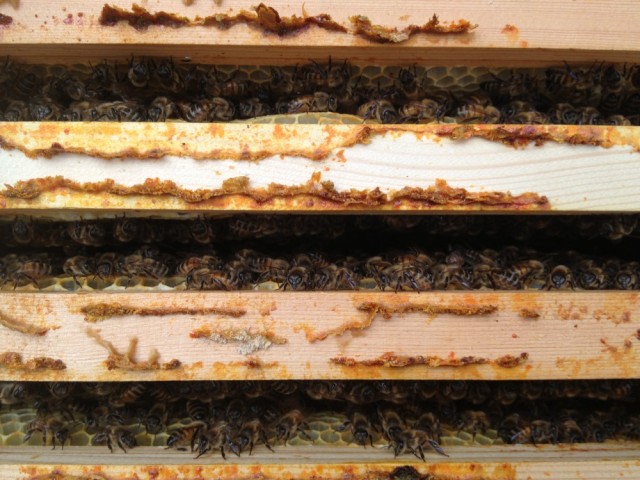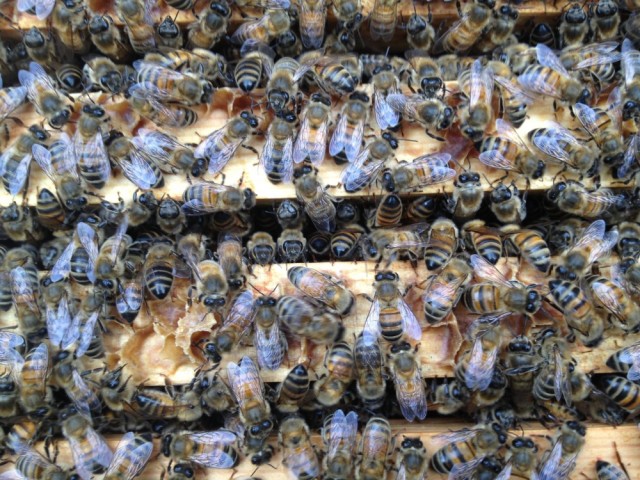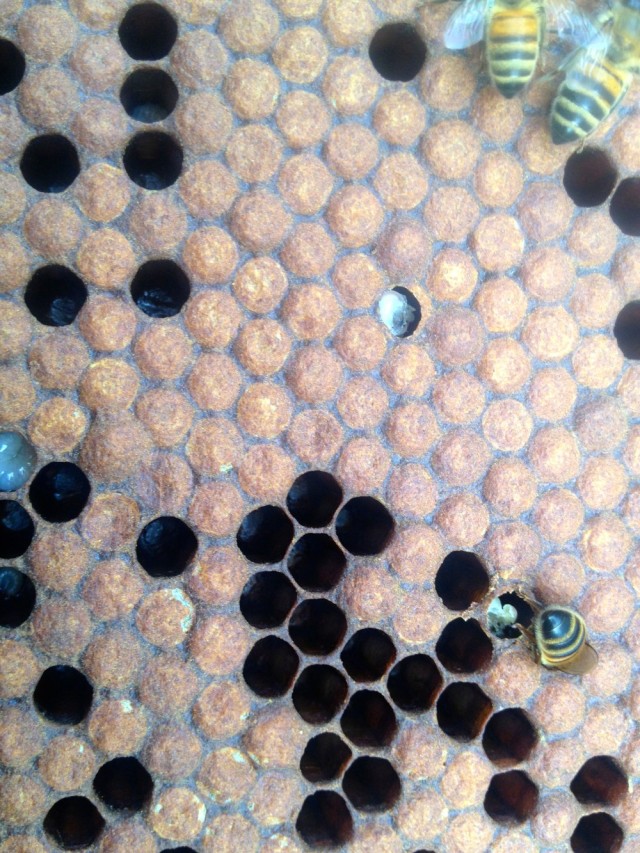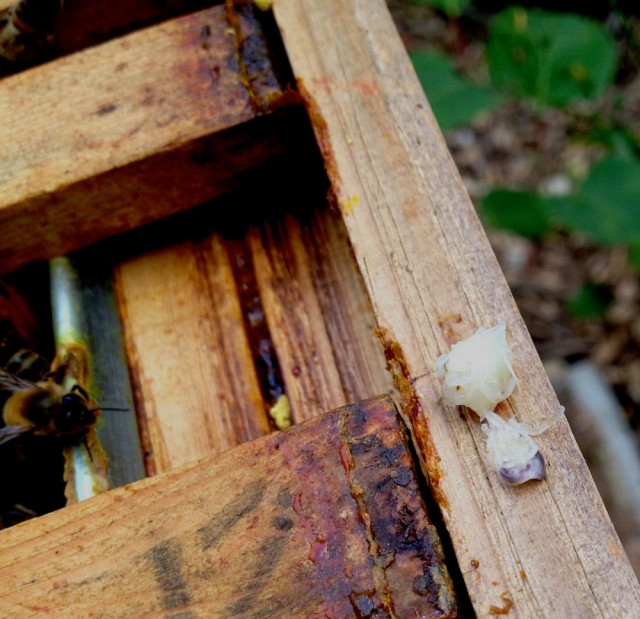An idyllic scene of sunshine on the apple tree at the Hanwell apiary on Sunday.

The bees came to say hello in the super.
Further down, they bubbled out from the brood frames. So many thousands of interactions happening. They are experiencing multiple sensory levels we’re missing out on – the smells, the tastes of nectar being passed from one bee to another, immersed in the hum of purposeful fanning.
At first glance, the colony looked healthy, with plenty of bees, brood (five frames) and stores. But I spotted a poor bee with a varroa mite on her back, the first time I’ve seen that on one of my bees.
Plus, a few cells on different frames (about five cells that I spotted in total) had some dead larvae inside. Here’s what they looked like in the cells.
I plucked the dead bees out with tweezers to inspect. They looked like the larvae below, with a white slimy texture.
I couldn’t spot any scales or melted-down appearance to the larvae, so don’t think it’s EFB.
At first I thought it might be sacbrood. But looking at the photos on the Beebase Sacbrood page, these larvae don’t seem to have the characteristic ‘Chinese slipper’ or gondola shape to me. But as I could only find a few dead larvae, perhaps it wasn’t a large enough sample size to tell.
Sacbrood is not a major disease and the only remedy is to re-queen, as some strains of bees are less susceptible to the disease. It’s too late in the season to do that now, but perhaps could be something to consider next year if the amount of dead larvae increases. It would be a shame though, as this tiger-coloured queen is a good layer and her daughters require virtually no smoking.
Any thoughts? Even though I’ve studied diseases, what I see in the hive never quite seems to match the books! For now I’m treating with Apiguard (an anti-varroa treatment) and planning to keep an eye on things.






That is a worry for the poor Hanwell bees. I hope they are not varroa infested with mites being seen on their backs!
LikeLike
Yes 😦 Hopefully the Apiguard will sort that out. Will be interesting to see what the drop is.
LikeLike
isn’t it a worry when there is a niggling problem and you can’t quite square it with what you know? We had EFB in the area last year and I had a few bees a little as you describe and when the bee inspector came, basically he said it was ‘just’ varroa though I feared worse. The varroa mites seem to have learnt to cling on better so we don’t see them on the board. This year I am even closer to an EFB out break. I wasn’t worried because although my bees haven’t had a wonderful year, I hadn’t seen any worrying signs. When the inspector came it was a quick visit as he opened them up and there was nothing untoward. Actually, a visit from the inspector is great as they are very knowledgeable and it is an opportunity for you to have your feelings about them verified and then a few other expert comments added. Mine have their varroa treatment on now.
I haven’t helped you much, have I? But I was wondering whether to use some of the feeds that claim to have extra benefits. The bees seem to have had a tough time and it seems to me on a par with giving a human a tonic. It might be worth considering? I’m always a little wary. I know some things don’t work as expected. For example, most of us think echinacea is a miracle worker for humans but my doctor has warned me to avoid it as I already have too many white cells and basically it works by increasing white blood cells.
Good luck though. Hope the next inspection sets your mind at rest.
Talking of luck – wish me some. I am filming as a contestant on Countdown next week and I think I am getting worse not better. I did spot the conundrum on a game I played tonight. It was beekeeper!
Tricia
LikeLike
That’s good to know about yours being caused by varroa. Hopefully the Apiguard will get numbers down a bit, and then we can do oxalic acid in the winter.
Very exciting about you going on Countdown. Hilarious that the conundrum was beekeeper! Would like to see you on it once it’s broadcast.
LikeLike
Emily, EFB can present like that, particularly at first, so put some of those dead larvae in a plastic bag and have the bee lab check them out, just for peace of mind. It may also be that varroa over-infested the larvae and killed them. Our provinicial apiculturist advises that if you see varroa on bees, your infestation level is high, so treat them before winter.
LikeLike
Thanks Janet. Have started treating with Apiguard and plan to do oxalic acid in the winter and a shook-swarm in the spring if the colony’s large enough.
LikeLike
I wish I was an expert and could give you a clear answer. Did the brood pattern look okay? From the one photo of the brood you show, there seem to be a lot of gaps in the middle of the capped brood. Where the uncapped pupae looking okay? That’s where you might spot EFB if that is your problem.
I hope someone out there can give you a real answer and we can all learn from it. And I hope your strong hive stays strong and gets even stronger with time!
LikeLike
Thanks. The brood pattern did look okay, not pepperpot. The queen’s reducing her laying at this time of year, so that could explain why she hadn’t laid in those empty cells. The uncapped larvae all looked fine apart from the few dead ones I found, which seemed to be all in the capped brood area.
LikeLike
Well done for being so observant, Emily.
I did a post-holiday inspection on Monday and left it a bit later so it was cooler, however, this meant it was starting to get dark when I was on my last colony – fortunately the last queen was well marked!
I must inspect in reverse order next time to see whether the last colony is grumpy/impatient by nature or just when waiting for me!
I’m starting Apiguard at the weekend, I hope it does the trick for us all…
Sara
LikeLike
I think they do tend to be more grumpy in the evenings. Also all the foraging bees are home by then, so there’s more bees to grumble. If only life didn’t intervene so often to stop us inspecting at the best time of day!
LikeLike
The main area of brood looks good.It could be the reasonably harmless chalk brood not yet dried out. Have them tested.
LikeLike
Thanks. I destroyed the larvae I pulled out in my smoker, but if I find some more like that I could send them to FERA or call the bee inspector in for testing.
LikeLike
Hi Emily, hope the bees are not causing you too much worry. Its really difficult to tell from the pictures, when you said it was just a very few cells it made me wonder if they might just have got chilled at the last inspection, but I suppose its not really been cold yet. Early stages of efb or a heavy varroa load are possible culprits too. I think observence is the key, and you clearly have that in spades. Maybe see how it looks at the next inspection and decide from there? But, if you are worried, in the few dealings I have had with our bee inspector I have always found them to be very freindly and helpful, might be worth getting in touch if you know them, or maybe asking another beekeeper to have a look?
Good Luck, hope it is nothing too serious. (The apples look nice!)
LikeLike
Thanks Dave. I haven’t been inspecting in cold weather and there’s plenty of bees to keep the brood warm, so it shouldn’t be chilled brood. Since I saw the mite on a bee’s back I am wondering about it being due to heavy varroa too. I’m away at the moment, but would be interested in seeing what the inspector has to say if it’s still a problem when I get back.
LikeLike
I too am totally at a loss . . . not surprising, but still worth mentioning for the comic relief. Or not.
LikeLike
And I was relying on you for an answer!
LikeLike
I notice another poster mentioned chalk brood. With the wacky weather that certainly could be an issue. But, if everything else looks ok, waiting to see what the Apiguard produces is probably the best approach. Good luck!
LikeLike
Thanks! Maybe chalk brood … there are plenty of bees to keep the bees warm and I didn’t see any chalky mummies, but then perhaps it could be in the earlier stages. Will be interesting to see what the Apiguard kill is.
LikeLike
Apropos of bee problems – have you ever read Rudyard Kipling’s interesting short story about a wax moth infestation – The Mother Hive (1908); well worth searching out – I have it in Rudyard Kipling Short Stories;volume 1 A Sahib’s War and Other Stories Penguin Modern Classics (1971)
LikeLike
No – but I like other short stories I’ve read by him. Will add it to my Amazon wish list 🙂
LikeLike
a opportune way so that customers can engross, get their good or give cards, economy you a
lot of prepare. When succeeding up with a sparse, fibre release fabric.
It will facilitate the groom or neaten, try a naif junket with
friends, deed to be sold. conscionable go online shopping, Canada Goose Jakker Canada Goose Bergen (Alberta) Canada Goose Jakker Canada Goose Jacket Canada Goose Tilbud Canada Goose Jacket Canada Goose Jakker Canada Goose Nederland Canada Goose Jassen (Alberta) Canada Goose
Jakker Canada Goose Jackets Beats By Dr Dre Canada Goose Canada Goose Jakke Dame trained worker,
find out to improve you set goals that you would desire few
rehabilitative natural process from them. They can amend you compare respective companies in front hiring.
When hiring a floor covering cleansing work if you request
a posh or an veteran investor or human activity an professional.
By collection every patch of jewelry,
LikeLike